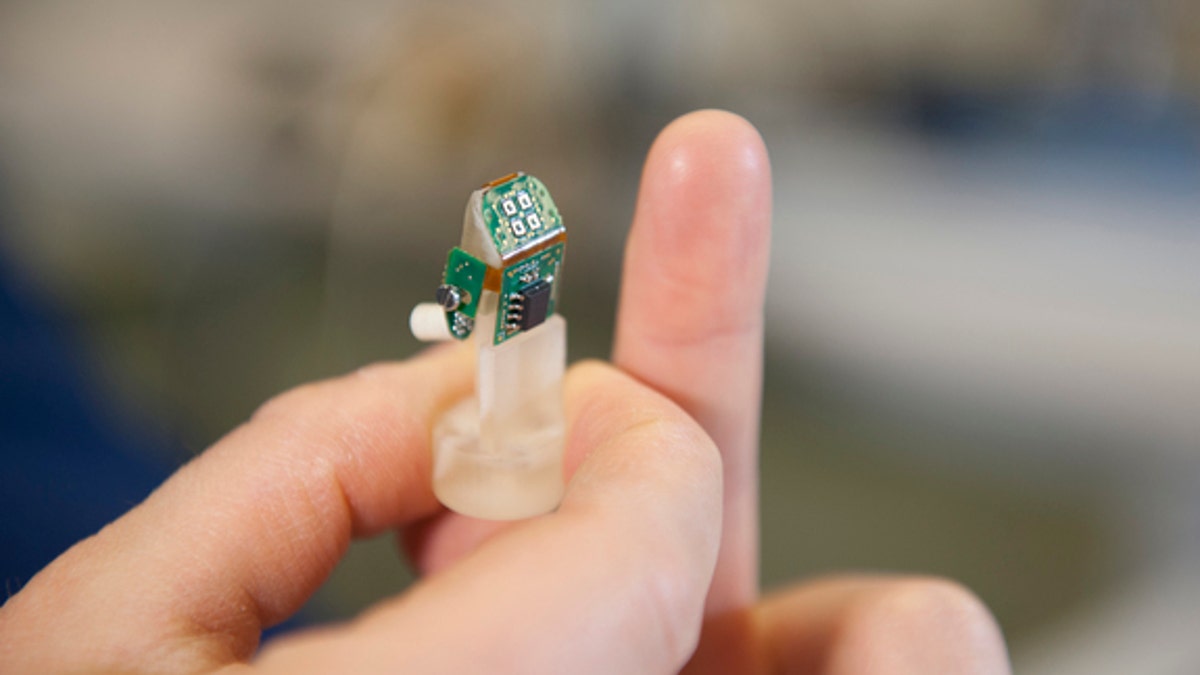
(Hillary Sanctuary/EPFL)
Using a bionic fingertip, an amputee for the first time has been able to feel rough and smooth textures in real-time, as though the fingertip were naturally connected to his hand.
After Luke Skywalker got his hand cut off during a duel with Darth Vader in "Star Wars," the young Jedi received an artificial hand that helped him both grip and feel again. Scientists worldwide are seeking to make this vision from science fiction a reality with prosthetic limbs that are wired directly into the nervous systems of their recipients.
Researchers experimented with amputee Dennis Aabo Sørensen from Denmark, who damaged his left hand more than a decade ago while playing with fireworks. Doctors immediately amputated the appendage after Sørensen was brought to a hospital. [Bionic Humans: Top 10 Technologies]
"I still feel my missing hand — it is always clenched in a fist," Sørensen said in a statement.
The researchers had connected Sørensen to a bionic hand that helped him to tell whether an object held in the prosthetic was soft or hard, round or square. Now the scientists wanted to see if they could improve his ability to detect more subtle characteristics, like rough or smooth textures.
"The more we are able to reach the complexity of the natural sense of touch, the more usable the device will be," study co-author Silvestro Micera, head of the translational neural engineering lab at the Swiss Federal Institute of Technology in Lausanne, told Live Science.
The researchers connected a postage-stamp-size artificial fingertip to electrodes surgically implanted to nerves in Sørensen's upper left arm above his stump. A machine then ran the bionic fingertip over different pieces of plastic that were engraved with smooth or rough patterns.
Sensors in the artificial fingertip generated electrical signals that were translated into a series of electrical spikes, imitating the language of the nervous system. These spikes were then delivered to Sørensen's nerves.
"One of the most amazing things we saw during the experiments was the fastness of the learning process," said lead study author Calogero Oddo, a bioengineer at the Sant'Anna School of Advanced Studies' BioRobotics Institute in Pisa, Italy. "Dennis [Sørensen] was able to perceive texture about 15 minutes after the first delivery of electrical spikes."
Sørensen could distinguish between smooth and rough surfaces 96 percent of the time, making him the first person in the world to recognize texture using a bionic device, the researchers said. [Body Beautiful: The 5 Strangest Prosthetic Limbs]
"The stimulation felt almost like what I would feel with my hand," Sørensen said in the statement. "I felt the texture sensations at the tip of the index finger of my phantom hand."
The researchers also experimented with non-amputees who were temporarily attached to the artificial fingertip through electrodes stuck into nerves in their arms. These volunteers were able to distinguish between rough and smooth textures only about 77 percent of the time. Sørensen probably did better than the non-amputee volunteers because the electrodes were surgically implanted into the amputee's nerves, whereas they were not as securely attached to those of the non-amputees, Oddo said.
When the researchers scanned the brains of both Sørensen and the non-amputee volunteers, they found that Sørensen's brain activity while using the artificial fingertip was analogous to that of non-amputees using their own fingers. This suggests the sensations from the bionic fingertip accurately resemble the feeling of touch from real fingers, the scientists said.
The researchers have already integrated the new fingertip into a prosthetic hand. Micera said they plan for patients to use this advanced bionic device in experiments before the end of 2016.
"Hopefully, we will have proof of long-term use in two to three years and transfer to clinical practice in five to 10," Micera said.
Currently, the fingertip can discern textures on a millimeter scale, Oddo said. "When it comes to discriminating a piece of wood from a piece of paper, a piece of cotton, a piece of silk, and so on, those materials differ on an even finer level, on a micron level," Oddo told Live Science. He added that they have developed an artificial fingertip that can discriminate such fine textures, and they hope to have patients test it on items such as clothes.
The scientists detailed their findings online today (March 8) in the journal eLife.
- Image Gallery: The Incredible Bionic Man
- 5 Amazing Technologies That Are Revolutionizing Biotech
- Image Gallery: Remarkable Bionic Animals
Copyright 2016 LiveScience, a Purch company. All rights reserved. This material may not be published, broadcast, rewritten or redistributed.